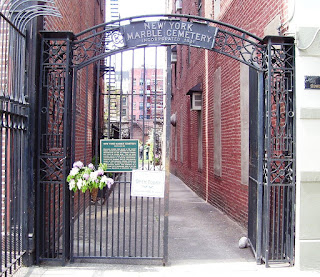American Plague: How Yellow Fever Epidemics in the 19th Century led to New York City's Two Strangest Cemeteries

There are no headstones. A narrow wrought iron gate off of 2nd Avenue opens and leads into a confined and claustrophobic alleyway. This spot is barely visible from the sidewalk and most pedestrians walk by without giving the place even so much as a second glance. The alleyway ends in a small grassy clearing that is only a half acre wide and enclosed by stone walls on all sides. This is the New York Marble Cemetery and it is one of the smallest, most obscure and oddest burial grounds in all of America’s largest city. At one time the official address of the New York Marble Cemetery was 41 and a half 2nd Avenue. Just a few blocks over, there is another cemetery almost exactly like this one, though slightly less well hidden from public view, called the New York City Marble Cemetery. These two cemeteries were opened in 1830 and 1831, respectively, at a time when burial underground in coffins was banned out of fear of contracting a disease by coming in c

